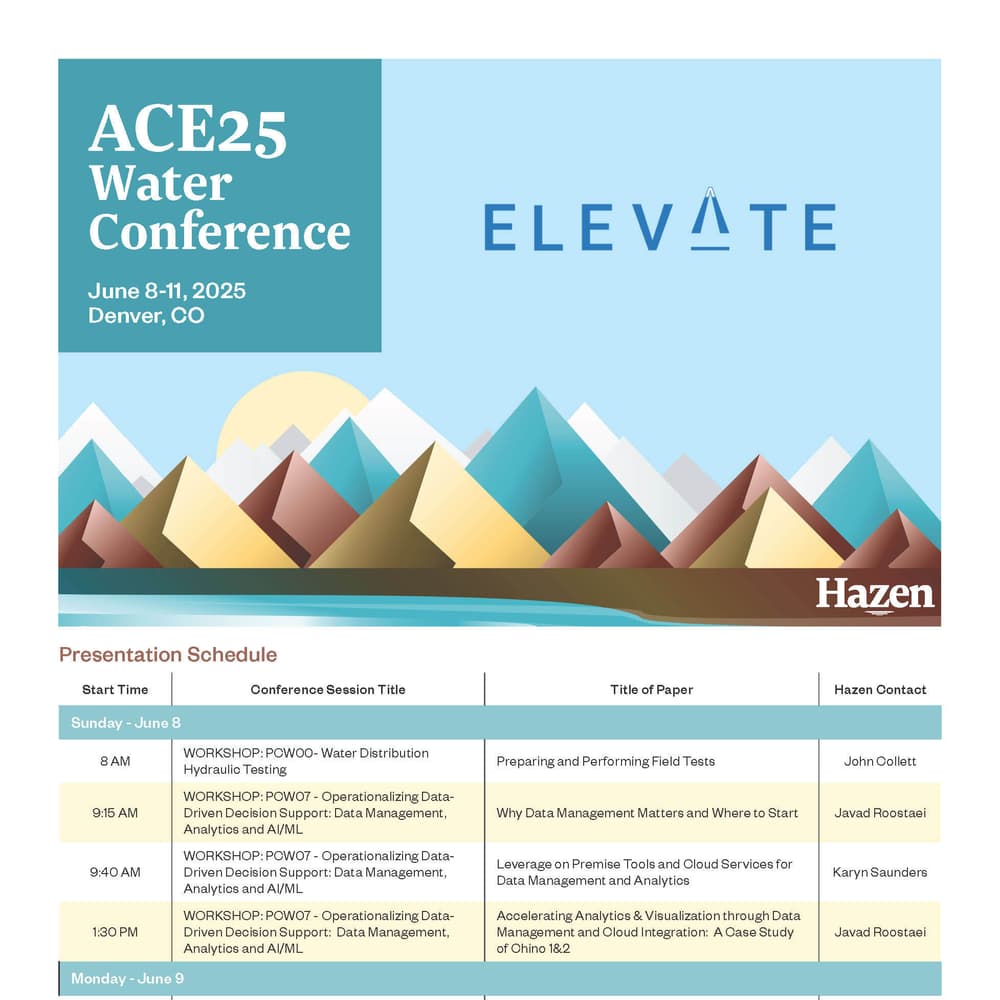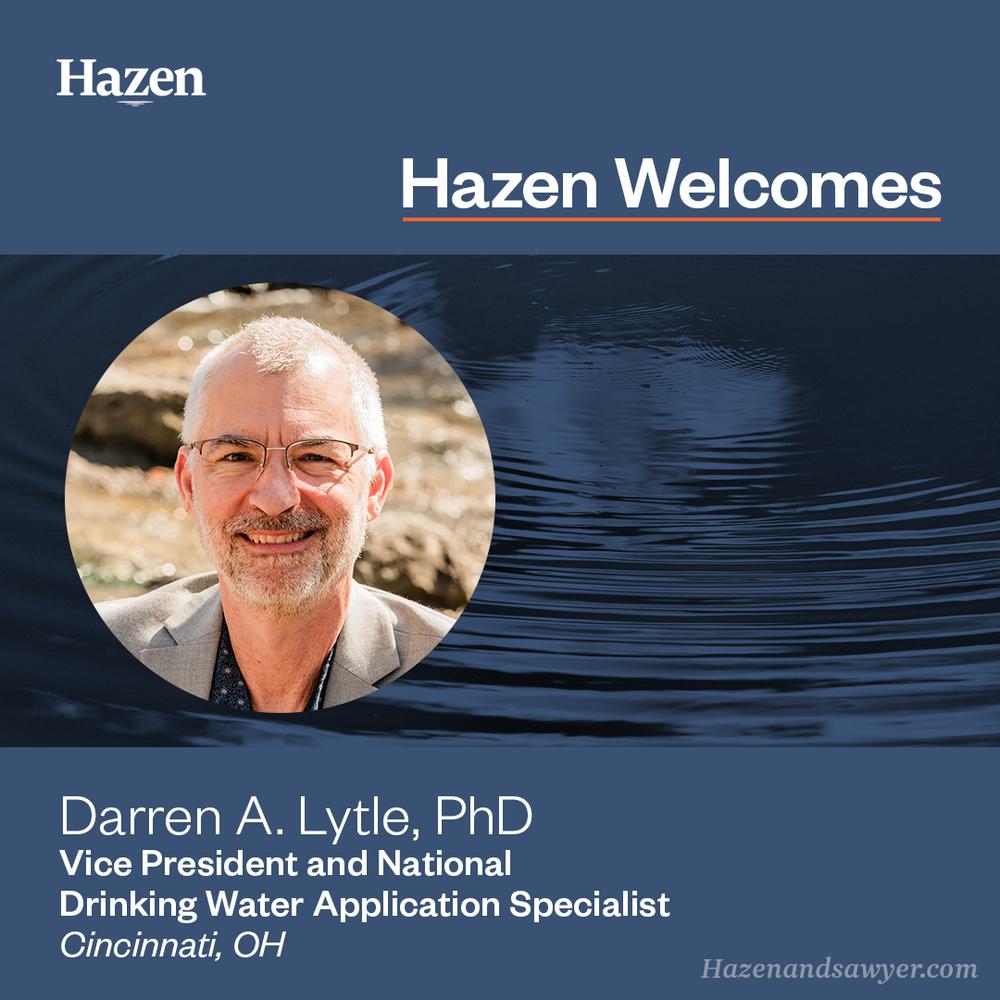Impact of Wildfires on Treatment Plant Operations and Design
Wildfires can threaten water supplies and significantly impact source water treatment
Extreme droughts, higher temperatures, earlier snowmelt, and changes in precipitation patterns can all contribute to the likelihood of wildfires. Wildfires affect water quantity, water availability, water quality, and can significantly impact a utility’s ability to effectively treat wildfire-impacted source water.
Related Topics:


Forested watersheds serve as high-quality drinking water sources for many communities—making water quantity and quality inextricably linked to forest soil properties. Wildfire changes to those soils are critical to understanding watershed effects of fire. In a 2018 WRF study, researchers at the University of Colorado at Boulder, with Hazen’s Dr. William Becker, simulated post-fire runoff by collecting soil and litter samples from the watersheds serving four different utilities throughout the United States. The samples were air dried and heated at a temperature of 225ºC, representing a medium temperature wildfire, and then leached into water. Evaluations of the water determined that litter tended to release more dissolved organic matter (DOM) following heating compared to soils, including an increase in sulfate, phosphate, iron, and manganese.
Although DOM is common and naturally occurring, in excess it can react with disinfectants to form disinfection byproducts (DBPs). The evaluation revealed the possibility of DBP maximum containment levels being exceeded, and exposure to DBP has been linked to cancer risks and reproductive developmental effects. Results of the evaluation also indicated that after a wildfire leachate will likely have a resistance to coagulation and require higher coagulant doses. These factors all have serious implications for operations and residual handling when treating water after a wildfire.

Wildfire's Effect on Conventional Water Treatment Unit Processes
Each unit process in a water treatment plant is dependent on the upstream processes ability to perform properly. Poor influent water quality after a wildfire can cause cascading effects throughout a conventional treatment train, and in severe cases poor water quality can force plants to shut down completely.
With the increase in extreme weather events, planning for future water-related vulnerabilities is more important than ever before and is a requirement of the new America’s Water Infrastructure Act. The concepts and recommendations presented here can apply to any utility anticipating any type of extreme weather events that increase source water turbidity, NOM, or nutrient loadings. Utilities under the threat of wildfires should consider the treatment implications specific to their watersheds.

Coagulation
All downstream processes rely on proper coagulation. Improper dosage of coagulant can result in poor flocculation, high settled water turbidity, high filtered water turbidity, and inadequate disinfection due to pathogen shielding. With wildfire leachate resistant to coagulation and requiring higher coagulant doses, in extreme erosion conditions coagulation alone may not be effective for meeting turbidity and TOC removal requirements.
Develop operational protocols and train utility staff to conduct on-site jar tests to respond to increased turbidity and NOM during extreme weather events. Post-fire increases in raw water NOM concentrations will almost always require an increase in coagulant dose, leading to increased particulate loading that may require adaptation to downstream processes. Streaming current monitors or zeta potential analyzers can also be installed to help determine optimum coagulant doses.
Wildfires can also impact raw water pH and alkalinity, affecting coagulation—chemical feed systems can be installed to adjust pH or add alkalinity. When using chemical feed systems or chemical storage, ensure that that they can deliver the higher doses that may be needed after a wildfire. Polymer feed facilities may also be needed to treat high ash content.
Flocculation
Increased solids loading to a filtration plant will not impact the design or operation of the flocculation process—with more particles, the flocculation process may even improve. But if the raw water turbidity increases dramatically, heavier particles may settle out in the flocculation basin, requiring more frequent periodic removal.
Flocculation (or slow mixing) promotes particle growth through particle on particle contact. In a conventional treatment plant, flocculation creates “settleable” floc that can be readily removed in a sedimentation basin. Changes in the concentration and character of NOM may also result in changes to floc formation.
This can be addressed by installing a means of removing silt settled at the bottom of the floc tanks and creating a plan to handle additional loads during high turbidity events. Train staff to monitor and adjust the mixing speed to prevent floc shear.
Sedimentation
Under typical conditions sedimentation basins sufficiently remove nearly all applied turbidity. Conventional sedimentation basins can adequately treat raw waters with turbidity up to 100 NTU, while DAF and adsorption clarifiers are limited to 10 NTU. If after a wildfire raw water turbidity is consistently above a clarification process’s normal upper limit—for both conventional sedimentation and high-rate clarification—a pre-sedimentation basin should be installed. The basin should be able to be bypassed during normal conditions.
If large conventional sedimentation basins are not practical, plate settlers can also be used. In areas where high turbidity will not likely reach the intake, consider dissolved air flotation to address algal bloom concerns.
Elevated turbidity or changes in NOM will also mean an increase in coagulant dose which will further increase the solids load. This can result in thousands of pounds per day of additional solids that must be removed, collected, processed, and disposed. An automated sludge removal system in the basins can be used to enhance solids removal.
Filtration
As the final particle removal process in drinking water treatment plants, granular media filters depend on effective coagulation to create particles large enough to be removed. Particles not removed earlier in the process by sedimentation enter the filters. As particles are removed in a granular media filter, head loss accumulates and eventually the filter must be backwashed. If the time between backwashes is too short, then the plant cannot produce enough water to meet demands and more waste backwash water may be produced than can be handled.
If coagulant doses are not increased enough to address an uptick of NOM after a wildfire, higher water turbidity would cause higher filter head loss, shorter filter runs, and more frequent backwashes and waste backwash water. Utilities should consider having enough backwash water and waste backwash storage so that multiple filters can be backwashed simultaneously.
Inadequate coagulant dose can also lead to poorer particle removal in filters and higher finished water turbidity. Larger media filters with deeper beds can increase solids storage, and inspections should be conducted frequently to ensure the filters are in good condition. Inside the filters, granular activated carbon can be used instead of anthracite to help with taste and odor.

Membranes
Microfiltration or ultrafiltration membranes, where particles are removed by straining, are a common alternative to granular media filters. Although finished water quality is not normally affected by changes in raw water quality, increased NOM can affect the rate of membrane fouling. When membranes become fouled, they need to be chemically cleaned.
Water quality changes following fires can overwhelm and cause excessive fouling in membrane water treatment plants, especially when sedimentation is not practiced. Membrane-based treatment should not be used in areas where raw water will be subject to firefighting foams and other substances that could foul membranes. For those already using membranes, adding powdered activated carbon can help adsorb firefighting foams before they reach the membranes.
Disinfection
Higher levels of NOM can lead to exceeding DBP maximum-containment levels. To prevent DBP compliance issues, maximize removal of NOM pre-disinfection, or use alternative disinfectants like UV or ozone.
Advanced Treatment
After a fire, smoky tastes and odors can permeate water. Nutrient release from wildfires could also result in long-term eutrophication and increased algal growth in downstream reservoirs, leading to additional taste and odor issues and algal toxins. Installing powdered activated carbon, post-filter GAC contactors, or ozone/biofiltration can address these issues.










